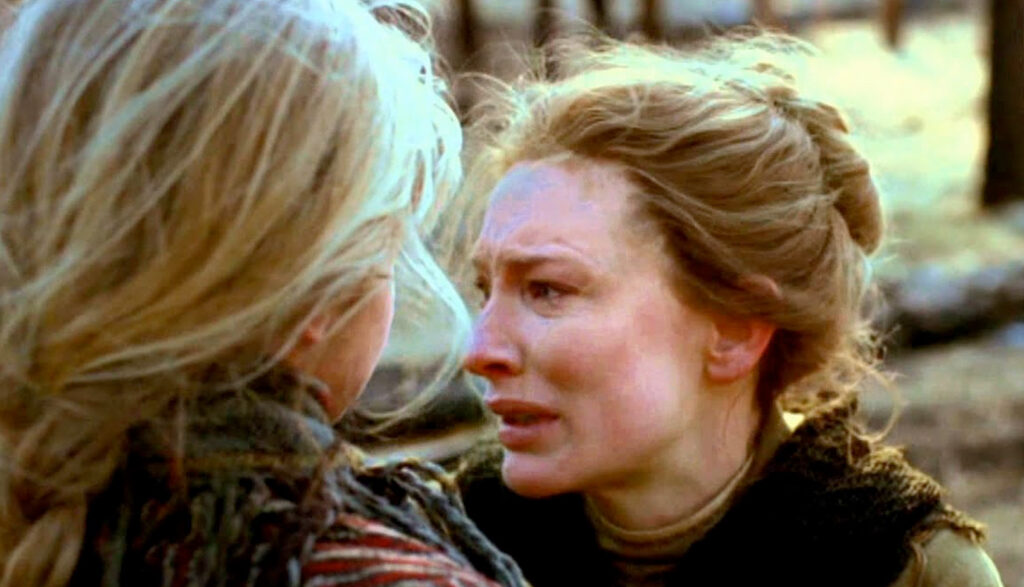
Maggie Gilkeson is a hard-working rancher trying to raise two daughters in the Christian tradition. With the help of hired hands, she tends cattle in a remote, lawless territory of the American Southwest in 1885, and nurses sick people on the side (her medical wisdom earns her the title “healer”). One day, after 20 years of living with the Apache Indians, Maggie’s estranged father (who goes by the name Jones) emerges from the forest in need of care. He gets an icy reception. But upon learning that her teenage daughter, Lilly, has been kidnapped by savages selling young girls as slave laborers in Mexico, Maggie must rely on the instincts and skills of the father she hates if they have any hope of saving her.
The pair is joined by Maggie’s younger daughter, Dot, a feisty pioneer woman in her own right who refuses to be left on the sidelines. The army is no help. Time is running out. So they begin tracking the murderous band led by a witchdoctor named Pesh-Chidin. Meanwhile, Lilly hatches her own plans to escape her despicable captors. Not only is this Western about a mother recovering her daughter, it’s also about Jones recovering his daughter after decades of alienation and Maggie’s struggle to forgive him for years of pain.
A central theme in The Missing is prejudice, specifically between whites and the native Americans of that day, but by extension to anyone of any era. While Dot has her romantic image of Indians dashed by the brutality of one small group, Maggie and Lilly have always been generally distrusting of the tribesmen. They are neighbors to be endured. Maggie’s disdain comes, in part, from her father’s decision to abandon his family for their nomadic way of life. She soon realizes that not all Indians are the enemy, just as all white men aren’t necessarily friends. When asked to nurse the wounds of a young man injured in battle, Maggie confesses that she has never worked on an Indian before. Chiding her for her innate prejudice, Jones says sarcastically, “They have green blood and there’s a pine cone in their chest instead of a heart.”
A number of characters place great value on “family.” Jones states that it’s a priority in Apache culture. A warrior and his adolescent son bravely set out to rescue the boy’s fiancée from the same marauding thugs who stole Lilly. On more than one occasion, a father gives his very life protecting or serving his child. Maggie, Dot and Jones pursue Lilly at great personal risk. Jones rescues Dot from drowning. When one of Lilly’s fellow hostages is forced to leave her baby behind, Lilly races back for it and is beaten for her noble gesture. Hired-hand Brake is very hospitable to Jones and invites him to share their meager meal. Reunited sisters exchange kind words, tenderness and hopes for the family’s future. Maggie battles guilt over being too strict with Lilly, an act that created circumstances leading to her abduction. Realizing he has let his daughter down, Jones opines, “There’s nothing a man can do to protect his family from himself.”
Maggie, a spiritual woman, is referred to as “a good Christian who won’t turn away any man in need.” When informed that a patient is running a high fever, she tells Dot to recite Psalm 23 until she can get there. Maggie talks of having prayed frequently following her father’s desertion (though one of her prayers was that he would die), and prays for him later in the story, invoking the name of Jesus. She values the cross around her neck, says grace at dinnertime, speaks of doing her “Christian duty” in helping others, utters “Lord protect us” in a moment of crisis, and is committed to burying the deceased in a “proper Christian” manner. Upon being told that she may have no choice but to kill the enemy, she prays, “Mother of Jesus, you watched your child suffer. Give me strength.” Before committing suicide, a woman utters, “Lord, forgive me.”
Jones embraces a very different form of spirituality, yet respects Maggie’s beliefs. He believes in the protective power of religious beads. He offers them to Maggie for herself and Dot (she lets him put them on her daughter, but refuses them for herself … at first). A shaman told Jones that the health of his eternal soul depended on prayer, avoiding rabbit meat for a year and taking care of his family. Jones chants a prayer and communicates with a falcon. Other chants are sewn into the fabric of the film’s soundtrack.
Do the filmmakers really believe those chants possess power? The tribal elders who acted as their advisors do, and were careful about how black magic was being used on the set. Director Ron Howard told Entertainment Weekly, “They wouldn’t give us the really powerful chants. They just refused. So they gave us approximations that wouldn’t bring any sort of bad luck on anyone. It reminded me of when we were making Ransom and the FBI wouldn’t give us the real kidnapping and abduction techniques because they didn’t want anybody to use them.” (Hmm. Apparently someone believes people take cues from movies.)
Elsewhere, the evil Pesh-Chidin is called “brujo,” which is Spanish for “witch.” This slave trader/witchdoctor casts a spell over Maggie that causes her to fall deliriously ill (it is presumably broken by a combination of Indian ritual and Bible reading). An ignorant, superstitious man, he is spooked by a flaw in a photograph that casts an unearthly glow around its subject. Part of Pesh-Chidin’s religion involves a reverence for rattlesnakes. Pesh-Chidin tells Jones there are two dogs at war inside of him and asks which will win. Jones responds with the age-old answer, “The one that gets fed,” and provides a useful analogy for the battle between flesh and spirit that Christians fight daily.
We learn that Brack typically sleeps in the main house, suggesting that his relationship with Maggie may be more intimate than professional. Soon afterward there’s a passionate kiss between them and an implied sexual encounter. Jones asks Maggie if Brack is the father of her girls, to which she says “no.” She explains that she was married to Dot’s father, but “didn’t get much of a look at” Lilly’s dad. A casual encounter? A rape? That statement never gets explained. Jones is referred to as a wandering spirit and serial monogamist. With the help of subtitles, we see Jones asking his Indian friend if he’s still “fooling around” with a certain squaw. There’s also a conversation about a woman being raped by a witch.
It’s what earned the film its R rating, though Howard demonstrates restraint in how bloody things get and how much he shows the audience of weapons making contact with their victims. Some punches get thrown. We see a bloody steer carcass following a coyote attack. Lilly is whipped by her captors. Soldiers shoot at Jones. An Indian finishes off a foe by firing an arrow into his chest at point-blank range. Pesh-Chidin blows poisonous dust into a man’s face, blinding him until he slowly bleeds to death from the eye sockets. Jones is beaten to within an inch of his life and left for dead. A naked man lies face-down with arrows in his back (one of several instances where corpses are discovered). Another has been butchered and strung up. Dot describes the brutality she overheard, clearly tormented by the memory of it.
People get shot with rifles, hacked with hatchets (not graphic), slashed and stabbed with knives, shot at with flaming arrows, thrown off of cliffs or injected with rattlesnake venom. A grief-stricken young mother turns a gun on herself. The kidnapped women are treated cruelly, though there’s no sexual abuse. The one time a drunk man attempts to force himself on a young lady, he is knocked cold before he can get very far. A flash flood endangers Jones and Dot. Maggie hopes to buy back her daughter from Pesh-Chidin rather than engage in violence, but Jones advises her, “The more we kill, the easier they’ll be to reason with.” Maggie gets slammed into a large rock. A man gets trampled by horses.
Not bad for an R-rated film. Just over a dozen profanities, including two s-words and one “g–d—.” Each of the daughters uses the phrase, “I swear to God.” Pesh-Chidin derogatorily refers to a man as a “squashed penis.”
Two men swig “fire water.”
A primitive tooth extraction is cringe-worthy. Combating racial prejudice is a good thing, but believers may take exception to scenes that paint the spiritually confused Jones as the picture of tolerance while Maggie—the Christian—struggles the most with prejudice. Also, authorities are portrayed as either uncaring or ineffective. That includes a local sheriff and even the U.S. military, which is slow to assist Maggie and quick to loot the home of a family they find murdered.
Prejudice. Forgiveness. Religious faith. Parent/child relationships. Personal redemption. These themes and others make The Missing more substantive than your average cowboys and Indians, save-the-homestead Western. In fact, it goes out of its way to paint Native Americans and whites as equally human and complex. What makes a person good or evil isn’t the race they were born into, but which path they choose to take as individuals. Ron Howard (who as a young man co-starred in John Wayne’s final film, The Shootist) does another fine job behind the camera and gets solid performances from his cast. As the wannabe Indian who dropped out of society (a 19th century hippie of sorts), Jones wears his long gray hair and the crags in his weathered face like attendance pins from the school of hard knocks. The pale Blanchett is the embodiment of strength and maternal passion. And 10-year-old Jenna Boyd is just terrific, a blend of fair-haired innocence and courage well beyond her years.
It’s a shame the film is so violent. This is a story worth telling, but upon reflection it seems it could have been done with less intense conflict and even more left to the viewer’s imagination. Also, while the movie balances its portrayals of Christian faith and Native American shamanism without stumping for either, the abundance of spiritual counterfeits will leave some Christian adults feeling oppressed.

Our weekly newsletter will keep you in the loop on the biggest things happening in entertainment and technology. Sign up today, and we’ll send you a chapter from the new Plugged In book, Becoming a Screen-Savvy Family, that focuses on how to implement a “screentime reset” in your family!